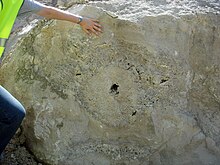User:Peter Mossdeep/sandbox


Thrombolites are ancient forms of microbial communities that can be either photosynthetic or heterotrophic. They are clotted accretionary structures formed in shallow water by the trapping, binding, and cementation of sedimentary grains by biofilms of microorganisms, especially cyanobacteria. They are now only found in a few places in the world. Stromatolites are similar but consist of layered accretions. The ancestors of thrombolites and stromatolites are thought to have contributed to the increase in oxygen in Earth's atmosphere.
Structure[edit]
Thrombolites have a clotted structure which lacks the laminae of stromatolites and each clot within a thrombolite mound is a separate cyanobacterial colony.[1] The clots are on the scale of millimetres to centimetres and may be interspersed with sand, mud or sparry carbonate.[1] The larger clots make up more than 40% of a thrombolite's volume and each clot has a complex internal structure of cells and rimmed lobes resulting primarily from the in situ calcification of the cyanobacterial colony. Very little sediment is found within the clots as the main growth method is calcification rather than sediment trapping.[1] However, due to the lack of a recognized worldwide handbook on the subject, there is a lack of coherent terminology used, which has led to confusion within the research of thrombolites.[2]
Etymology[edit]
Thrombolite is based on the Greek word θρόμβος (thrombus), which trnaslates to 'clot'.
Researched Clusters[edit]
Thrombolites have been observed and studied across the globe, such as in the Rocknest Formation in the Northwest Territories,[3] the Ediacaran Itapumuci Group in Paraguay,[4] and the Sorbas Basin in Spain.[5]
References[edit]
- ^ a b c Kennard, John M.; James, Noel P. (October 1986). "Thrombolites and Stromatolites: Two Distinct Types of Microbial Structure". PALAIOS. 1 (5): 492–503. Bibcode:1986Palai...1..492K. doi:10.2307/3514631. JSTOR 3514631.
- ^ Shapiro, Russell (April 2000). "A Comment on the Systematic Confusion of Stromatolites". PALAIOS. 15 (2): 166–169. doi:10.1669/0883-1351(2000)015<0166:ACOTSC>2.0.CO;2.
- ^ Kah, Linda C.; Grotzinger, John P. (June 1992). "Early Proterozoic (1.9 Ga) thrombolites of the Rocknest Formation, Northwest Territories". PALAIOS. 7 (3): 305–315. doi:10.2307/3514975.
- ^ Warren, Lucas V.; Fairchild, Thomas R.; Gaucher, Claudio; Boggiani, Paulo C.; Poiré, Daniel G.; Anelli, Luís E.; Inchausti, Julio C. G. (September 2011). "Corumbella and in situ Cloudina in association with thrombolites in the Ediacaran Itapucumi Group, Paraguay". Terra Nova. 23 (6). doi:10.1111/j.1365-3121.2011.01023.x.
- ^ Martin, Jose M.; Braga, Juan C.; Riding, Robert (January 1993). "Siliciclastic stromatolites and thrombolites, late Miocene, S.E. Spain". Journal of Sedimentary Research. 63 (1). doi:10.1306/D4267AAA-2B26-11D7-8648000102C1865D.
External links[edit]
- two distinct types of microbial structures
- a comment on systematic confusion of thrombolites
- early proterozoic thrombolites of the rocknest Formation
- corumbella and in situ cloudina in association with thrombolites in the ediacaran itapucumi group
- siliciclastic stromatolites and thrombolites late miocene spain
- etymology of thrombolites
Category:Trace fossils Category:Cyanobacteria

